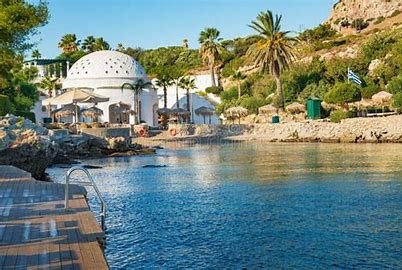Exploring Greece Beyond Santorini and Mykonos
There is no doubt that my country is one of the most beautiful places on earth and a top destination for tourists and travelers. However, there is more to it than meets the eye. Tourists only see images online of Athens' archaeological sites, Mykonos' white and blue views and nightlife, and the real-life paintings and sunsets of Santorini. As a local, who has lived abroad for 6 years now, I can tell you for a fact that most tourists limit their Greece trip to these destinations. Consequently, overtourism not only impacts the Greek lifestyle and environment, but also prevents travelers from truly experiencing Greek culture. Social media plays a big role in the overexposure of these specific destinations, which honestly helps to separate tourists who are looking for their next Instagram photo from travelers who want to truly experience the place they are traveling at. It is highly likely you belong to the second category if you are reading this blog, and I am here to give you more options!
Lefkada
On the west coast of Greece, Lefkada, also known as Lefkas, is a captivating Ionian island. It is connected to the mainland by a bridge and is known for its turquoise water, pristine beaches, and lush green landscapes. Among the most popular beaches on the island are Porto Katsiki and Egremni, which boast dramatic cliffs and crystal-clear waters. The strong winds blow across certain areas of the island make it a windsurfing and kitesurfing paradise. A glimpse into traditional Greek life can be found in the picturesque villages of Lefkada, such as Vasiliki and Agios Nikitas. Nydri Waterfalls and Lefkada, with its vibrant atmosphere and delicious Greek cuisine, are both worth visiting.
Nafpaktos
Located in Western Greece, Nafpaktos is a coastal town rich in history and charm. As the place where my mother grew up, it is one of my favorite hidden gems. Nafpaktos is a medieval town dominated by the impressive Nafpaktos Castle, which provides panoramic views over the Corinthian Gulf. Old Town's narrow streets are adorned with Venetian architecture, while the harbor is filled with colorful fishing boats. The town's two beaches, Psani and Gribovo, are ideal for relaxation and swimming. Nafpaktos hosts many cultural events and festivals throughout the year, making it a welcoming and vibrant place to visit.
Elafonisos
The small but enchanting island of Elafonisos is located in Greece's Peloponnese region. The stunning beaches and turquoise waters of Elafonisos, despite its relatively small size, make it look like a tropical paradise despite its relatively small size. Simos Beach, located along the island's southeastern coast, is one of the island's most popular attractions. In addition to the fine golden sand and sand dunes on Simos Beach, there are also sand dunes surrounding the crystal-clear waters. There are many species of plants and animals on the island, and it is also a great place to watch birds. Elafonisos is also an important stopover for migratory birds.
Chalkidiki
The trident-shaped peninsula of Chalkidiki extends into the Aegean Sea in three fingers. Each finger has its own distinctive character. Kassandra, the westernmost peninsula, is famous for its lively beaches, vibrant nightlife, and crystal-clear waters. With its picturesque fishing villages, secluded coves, and lush greenery, Sithonia, the middle finger, offers a more tranquil and natural experience. Finally, Mount Athos, the easternmost finger of the mountain chain, is an autonomous monastic state, and access is restricted to male pilgrims who have special permissions. Whether you're looking for relaxation, adventure, or cultural exploration, Chalkidiki has something for everyone. It boasts numerous Blue Flag beaches, charming villages, and an ancient history dating back to antiquity.
Crete
The largest of all Greek islands, Crete is home to a wide variety of attractions, including ancient archaeological sites like Knossos as well as spectacular mountain landscapes and beautiful beaches. Crete has a rich history, traditional villages, and delicious cuisine, making it a well-rounded destination. Zeus, the god king, was born there, according to Greek mythology. On the island, Knossos is a must-see archaeological site, which was once home to the Minoan civilization, the earliest advanced civilization in Europe. As it is decorated with intricate frescoes and has a complex layout, this ancient palace provides a glimpse into the sophisticated lifestyle of the Minoans.
Evia (Euboea)
Evia, Greece's second-largest island after Crete, lies close to the mainland and can be accessed by a bridge from Chalkida. This diverse island offers a blend of verdant landscapes, rugged mountains, and beautiful beaches. The northern part is known for its dense forests, while the southern part offers lovely coastal resorts and sandy beaches. Nature lovers will enjoy hiking, birdwatching, and exploring caves at Evia, a great destination for them. In Chalkida, the capital of Evia, water changes direction every six hours due to a unique tidal phenomenon known as the Euperipus Strait. For those seeking an authentic Greek experience, Evia offers a relaxed atmosphere and diverse attractions.
Rhodes
Today, the Colossus of Rhodes is considered one of the Seven Wonders of the Ancient World and is a UNESCO World Heritage Site because of its well-preserved medieval town. Located on Rhodes Island, the Old Town features cobbled streets, stone mansions, and ancient monuments including the Palace of the Grand Master and the Street of the Knights, all of which are surrounded by impressive medieval walls. With artifacts dating back to various historical periods, the Archaeological Museum offers a fascinating insight into Rhodes' past.




























